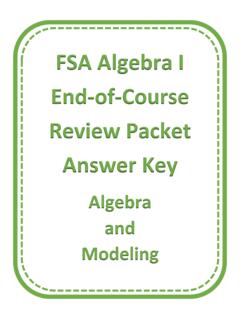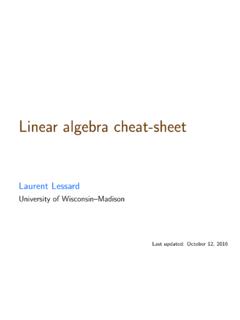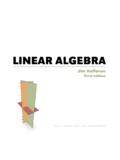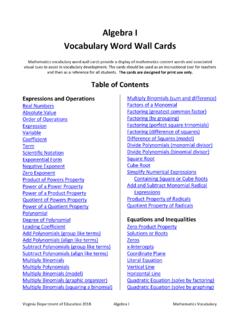Transcription of Matrix Theory and LINEAR ALGEBRA - Dalhousie University
1 Matrix Theory andLINEAR ALGEBRAAn open text by Peter SelingerBased on the original text by Lyryx Learning and Ken KuttlerCreative Commons License (CC BY) Matrix Theory and LINEAR AlgebraAn open text by Peter SelingerBased on the original text by Lyryx Learning and Ken KuttlerFirst editionCONTRIBUTIONSKen Kuttler, Brigham Young UniversityIlijas Farah, York UniversityMarie-Andr e B. Langlois, Dalhousie UniversityPeter Selinger, Dalhousie UniversityLyryx Learning TeamBruce BauslaughPeter ChowNathan FriessStephanie KeyowskiClaude LaflammeMartha LaflammeJennifer MacKenzieTamsyn MurnaghanBogdan SavaLarissa StoneRyan YeeEhsun ZahediCover photography by Pok RieLICENSEC reative Commons License (CC BY): This text, including the art and illustrations, are available underthe Creative Commons license (CC BY), allowing anyone to reuse, revise, remix and redistribute the view a copy of this license, visithttps:// reative li e nses /by/ historyCurrent revision: Dal 2018 AThis printing.
2 Version 487897b of January 10, 2022 Extensive edits, additions, and revisions have been completed by Peter Selinger and other extensive edits, additions, and revisions were made by the editorial staff at Lyryx new content (text and images) is released under the same license as noted 2018 A P. Selinger: updated title and front matter. P. Selinger: Extensive revisions and additions. Rewrote most of Chapters 9 11 from application on perspective rendering, error correcting codes, least squares approximationsand curve fitting, an audio demo for Fourier series, sketching of quadratic forms, and principalcomponent 2017 B P. Selinger, Langlois: Re-ordered chapters. Extensive revisions to Chapters 1 8.
3 Addednew sections on fields, cryptography, geometric interpretation of LINEAR transformations, recur-rences, systems of LINEAR differential A Lyryx: Front matter has been updated including cover, copyright, and revision pages. I. Farah: contributed edits and revisions, particularly the proofs in the Properties of DeterminantsII: Some Important Proofs B Lyryx: The text has been updated with the addition of subsections on Resistor Networks and theMatrix Exponential based on original material by K. Kuttler. Lyryx: New example on Random Walks A Lyryx: The layout and appearance of the text has been updated, including the title page and newlydesigned back A Lyryx: The content was modified and adapted with the addition of new material and severalimages throughout.
4 Lyryx: Additional examples and proofs were added to existing material A Original textby K. Kuttler of Brigham Young University . That version is used underCreative Commons license CC BY (https:// reative enses/ )made possible by funding from The Saylor Foundation s Open Textbook Challenge. SeeElementary LINEAR Algebrafor more information and the original Systems of LINEAR Geometric view of systems of equations.. Algebraic view of systems of equations.. Elementary operations.. Gaussian elimination.. Gauss-Jordan elimination.. Homogeneous systems.. Uniqueness of the reduced echelon form.. Fields.. Application: Balancing chemical reactions.
5 Application: Dimensionless variables.. Application: Resistor networks.. 562 Vectors Points and vectors.. Addition.. Scalar multiplication.. LINEAR combinations.. Length of a vector.. The dot product.. Definition and properties.. The Cauchy-Schwarz and triangle inequalities.. The geometric significance of the dot product.. Orthogonal vectors.. Projections.. The cross product.. Right-handed systems of vectors.. Geometric description of the cross product.. Algebraic definition of the cross product.. The box product.. 95vviCONTENTS3 Lines and planes Lines.. Planes.. 1104 Definition and equality.. Addition.
6 Scalar multiplication.. Matrix multiplication.. Multiplying a Matrix and a vector.. Matrix multiplication.. Properties of Matrix multiplication.. Matrix inverses.. Definition and uniqueness.. Computing inverses.. Using the inverse to solve a system of equations.. Properties of the inverse.. Right and left inverses.. Elementary matrices.. Elementary matrices and row operations.. Inverses of elementary matrices.. Elementary matrices and reduced echelon forms.. Writing an invertible Matrix as a product of elementary matrices.. More properties of inverses.. The transpose.. Matrix arithmetic modulop.. Application: Cryptography.. 1675 Spans, LINEAR independence, and bases Spans.
7 LINEAR independence.. Redundant vectors and LINEAR independence.. The casting-out algorithm.. Alternative characterization of LINEAR independence.. Properties of LINEAR independence.. LINEAR independence and LINEAR combinations.. Removing redundant vectors.. Subspaces ofRn.. Basis and dimension.. Definition of basis.. Examples of bases.. Bases and coordinate systems.. Dimension.. More properties of bases and dimension.. Column space, row space, and null space of a Matrix .. 2106 LINEAR transformations LINEAR transformations.. The Matrix of a LINEAR transformation.. Geometric interpretation of LINEAR transformations.. Properties of LINEAR transformations.
8 Application: Perspective rendering.. 2357 Determinants of 2 2- and 3 3-matrices.. Minors and cofactors.. The determinant of a triangular Matrix .. Determinants and row operations.. Properties of determinants.. Application: A formula for the inverse of a Matrix .. Application: Cramer s rule.. 2668 Eigenvalues, eigenvectors, and Eigenvectors and eigenvalues.. Finding eigenvalues.. Geometric interpretation of eigenvectors.. Diagonalization.. Application: Matrix powers.. Application: Solving recurrences.. Application: Systems of LINEAR differential equations.. Differential equations.. Systems of LINEAR differential equations.. Example: coupled train cars.
9 Application: The Matrix exponential.. Properties of eigenvectors and eigenvalues.. The Cayley-Hamilton Theorem.. Complex eigenvalues and eigenvectors.. 3179 Vector Definition of vector spaces.. LINEAR combinations, span, and LINEAR independence.. Subspaces.. Basis and dimension.. Application: Error correcting codes.. 35510 LINEAR transformation of vector Definition and examples.. The ALGEBRA of LINEAR transformations.. LINEAR transformations defined on a basis.. The Matrix of a LINEAR transformation.. 38111 Inner product Real inner product spaces.. Orthogonality.. The Gram-Schmidt orthogonalization procedure.. Orthogonal projections and Fourier series.
10 Application: Least squares approximations and curve fitting.. Orthogonal functions and orthogonal matrices.. Diagonalization of symmetric matrices.. Positive semidefinite and positive definite matrices.. Application: Simplification of quadratic forms.. Complex inner product spaces.. Unitary and hermitian matrices.. Application: Principal component analysis.. 472A Complex The complex numbers.. Geometric interpretation.. The fundamental theorem of ALGEBRA .. 491B Answers to selected exercises495 Index541 PrefaceMatrix Theory and LINEAR Algebrais an introduction to LINEAR ALGEBRA for students in the firstor secondyear of University . The book contains enough material for a 2-semester course.









